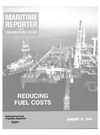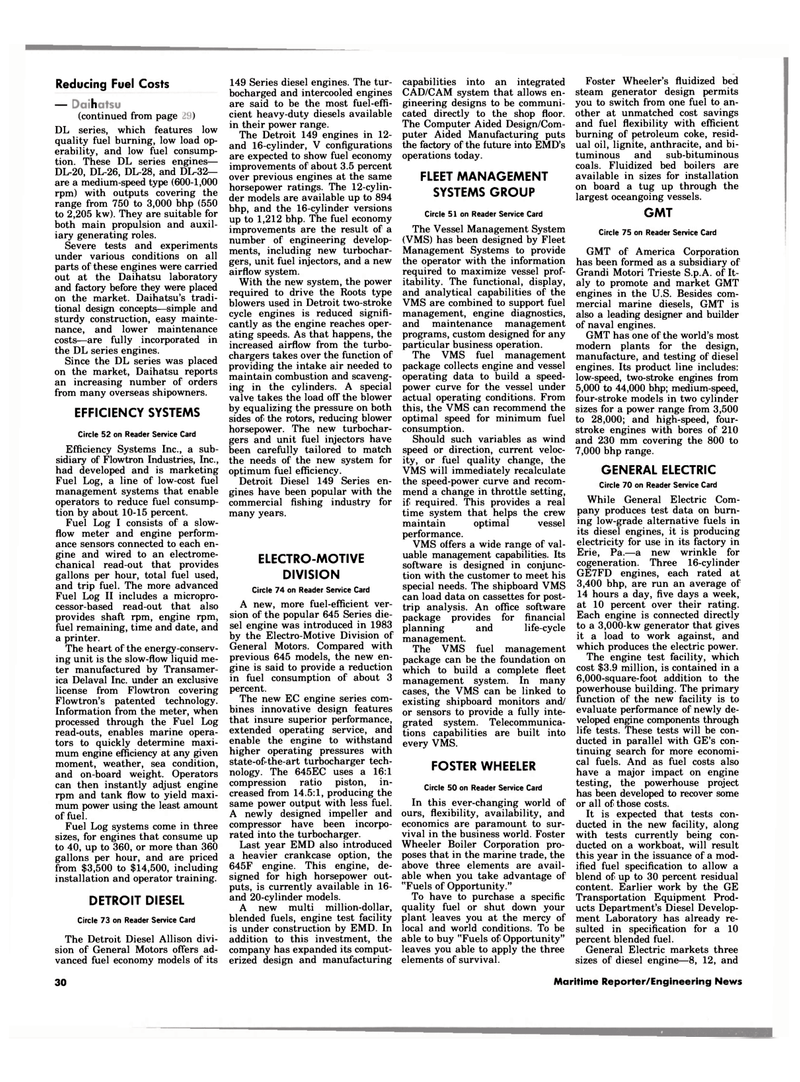
Page 28: of Maritime Reporter Magazine (January 15, 1984)
Read this page in Pdf, Flash or Html5 edition of January 15, 1984 Maritime Reporter Magazine
Reducing Fuel Costs — MWM Murphy (continued from page 33)
DL series, which features low quality fuel burning, low load op- erability, and low fuel consump- tion. These DL series engines—
DL-20, DL-26, DL-28, and DI^32— are a medium-speed type (600-1,000 rpm) with outputs covering the range from 750 to 3,000 bhp (550 to 2,205 kw). They are suitable for both main propulsion and auxil- iary generating roles.
Severe tests and experiments under various conditions on all parts of these engines were carried out at the Daihatsu laboratory and factory before they were placed on the market. Daihatsu's tradi- tional design concepts—simple and sturdy construction, easy mainte- nance, and lower maintenance costs—are fully incorporated in the DL series engines.
Since the DL series was placed on the market, Daihatsu reports an increasing number of orders from many overseas shipowners.
EFFICIENCY SYSTEMS
Circle 52 on Reader Service Card
Efficiency Systems Inc., a sub- sidiary of Flowtron Industries, Inc., had developed and is marketing
Fuel Log, a line of low-cost fuel management systems that enable operators to reduce fuel consump- tion by about 10-15 percent.
Fuel Log I consists of a slow- flow meter and engine perform- ance sensors connected to each en- gine and wired to an electrome- chanical read-out that provides gallons per hour, total fuel used, and trip fuel. The more advanced
Fuel Log II includes a micropro- cessor-based read-out that also provides shaft rpm, engine rpm, fuel remaining, time and date, and a printer.
The heart of the energy-conserv- ing unit is the slow-flow liquid me- ter manufactured by Transamer- ica Delaval Inc. under an exclusive license from Flowtron covering
Flowtron's patented technology.
Information from the meter, when processed through the Fuel Log read-outs, enables marine opera- tors to quickly determine maxi- mum engine efficiency at any given moment, weather, sea condition, and on-board weight. Operators can then instantly adjust engine rpm and tank flow to yield maxi- mum power using the least amount of fuel.
Fuel Log systems come in three sizes, for engines that consume up to 40, up to 360, or more than 360 gallons per hour, and are priced from $3,500 to $14,500, including installation and operator training.
DETROIT DIESEL
Circle 73 on Reader Service Card
The Detroit Diesel Allison divi- sion of General Motors offers ad- vanced fuel economy models of its 149 Series diesel engines. The tur- bocharged and intercooled engines are said to be the most fuel-effi- cient heavy-duty diesels available in their power range.
The Detroit 149 engines in 12- and 16-cylinder, V configurations are expected to show fuel economy improvements of about 3.5 percent over previous engines at the same horsepower ratings. The 12-cylin- der models are available up to 894 bhp, and the 16-cylinder versions up to 1,212 bhp. The fuel economy improvements are the result of a number of engineering develop- ments, including new turbochar- gers, unit fuel injectors, and a new airflow system.
With the new system, the power required to drive the Roots type blowers used in Detroit two-stroke cycle engines is reduced signifi- cantly as the engine reaches oper- ating speeds. As that happens, the increased airflow from the turbo- chargers takes over the function of providing the intake air needed to maintain combustion and scaveng- ing in the cylinders. A special valve takes the load off the blower by equalizing the pressure on both sides of the rotors, reducing blower horsepower. The new turbochar- gers and unit fuel injectors have been carefully tailored to match the needs of the new system for optimum fuel efficiency.
Detroit Diesel 149 Series en- gines have been popular with the commercial fishing industry for many years.
ELECTRO-MOTIVE
DIVISION
Circle 74 on Reader Service Card
A new, more fuel-efficient ver- sion of the popular 645 Series die- sel engine was introduced in 1983 by the Electro-Motive Division of
General Motors. Compared with previous 645 models, the new en- gine is said to provide a reduction in fuel consumption of about 3 percent.
The new EC engine series com- bines innovative design features that insure superior performance, extended operating service, and enable the engine to withstand higher operating pressures with state-of-the-art turbocharger tech- nology. The 645EC uses a 16:1 compression ratio piston, in- creased from 14.5:1, producing the same power output with less fuel.
A newly designed impeller and compressor have been incorpo- rated into the turbocharger.
Last year EMD also introduced a heavier crankcase option, the 645F engine. This engine, de- signed for high horsepower out- puts, is currently available in 16- and 20-cylinder models.
A new multi million-dollar, blended fuels, engine test facility is under construction by EMD. In addition to this investment, the company has expanded its comput- erized design and manufacturing capabilities into an integrated
CAD/CAM system that allows en- gineering designs to be communi- cated directly to the shop floor.
The Computer Aided Design/Com- puter Aided Manufacturing puts the factory of the future into EMD's operations today.
FLEET MANAGEMENT
SYSTEMS GROUP
Circle 51 on Reader Service Card
The Vessel Management System (VMS) has been designed by Fleet
Management Systems to provide the operator with the information required to maximize vessel prof- itability. The functional, display, and analytical capabilities of the
VMS are combined to support fuel management, engine diagnostics, and maintenance management programs, custom designed for any particular business operation.
The VMS fuel management package collects engine and vessel operating data to build a speed- power curve for the vessel under actual operating conditions. From this, the VMS can recommend the optimal speed for minimum fuel consumption.
Should such variables as wind speed or direction, current veloc- ity, or fuel quality change, the
VMS will immediately recalculate the speed-power curve and recom- mend a change in throttle setting, if required. This provides a real time system that helps the crew maintain optimal vessel performance.
VMS offers a wide range of val- uable management capabilities. Its software is designed in conjunc- tion with the customer to meet his special needs. The shipboard VMS can load data on cassettes for post- trip analysis. An office software package provides for financial planning and life-cycle management.
The VMS fuel management package can be the foundation on which to build a complete fleet management system. In many cases, the VMS can be linked to existing shipboard monitors and/ or sensors to provide a fully inte- grated system. Telecommunica- tions capabilities are built into every VMS.
FOSTER WHEELER
Circle 50 on Reader Service Card
In this ever-changing world of ours, flexibility, availability, and economics are paramount to sur- vival in the business world. Foster
Wheeler Boiler Corporation pro- poses that in the marine trade, the above three elements are avail- able when you take advantage of "Fuels of Opportunity."
To have to purchase a specific quality fuel or shut down your plant leaves you at the mercy of local and world conditions. To be able to buy "Fuels of Opportunity" leaves you able to apply the three elements of survival.
Foster Wheeler's fluidized bed steam generator design permits you to switch from one fuel to an- other at unmatched cost savings and fuel flexibility with efficient burning of petroleum coke, resid- ual oil, lignite, anthracite, and bi- tuminous and sub-bituminous coals. Fluidized bed boilers are available in sizes for installation on board a tug up through the largest oceangoing vessels.
GMT
Circle 75 on Reader Service Card
GMT of America Corporation has been formed as a subsidiary of
Grandi Motori Trieste S.p.A. of It- aly to promote and market GMT engines in the U.S. Besides com- mercial marine diesels, GMT is also a leading designer and builder of naval engines.
GMT has one of the world's most modern plants for the design, manufacture, and testing of diesel engines. Its product line includes: low-speed, two-stroke engines from 5,000 to 44,000 bhp; medium-speed, four-stroke models in two cylinder sizes for a power range from 3,500 to 28,000; and high-speed, four- stroke engines with bores of 210 and 230 mm covering the 800 to 7,000 bhp range.
GENERAL ELECTRIC
Circle 70 on Reader Service Card
While General Electric Com- pany produces test data on burn- ing low-grade alternative fuels in its diesel engines, it is producing electricity for use in its factory in
Erie, Pa.—a new wrinkle for cogeneration. Three 16-cylinder
GE7FD engines, each rated at 3,400 bhp, are run an average of 14 hours a day, five days a week, at 10 percent over their rating.
Each engine is connected directly to a 3,000-kw generator that gives it a load to work against, and which produces the electric power.
The engine test facility, which cost $3.9 million, is contained in a 6,000-square-foot addition to the powerhouse building. The primary function of the new facility is to evaluate performance of newly de- veloped engine components through life tests. These tests will be con- ducted in parallel with GE's con- tinuing search for more economi- cal fuels. And as fuel costs also have a major impact on engine testing, the powerhouse project has been developed to recover some or all of those costs.
It is expected that tests con- ducted in the new facility, along with tests currently being con- ducted on a workboat, will result this year in the issuance of a mod- ified fuel specification to allow a blend of up to 30 percent residual content. Earlier work by the GE
Transportation Equipment Prod- ucts Department's Diesel Develop- ment Laboratory has already re- sulted in specification for a 10 percent blended fuel.
General Electric markets three sizes of diesel engine—8, 12, and 30 Maritime Reporter/Engineering News

 27
27

 29
29
